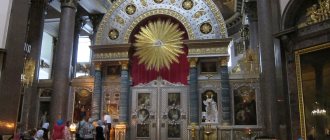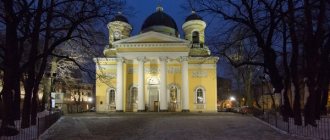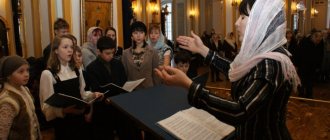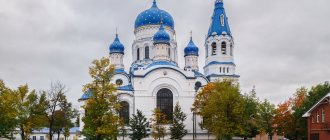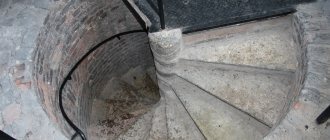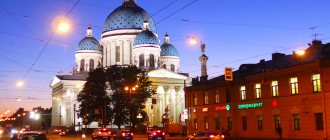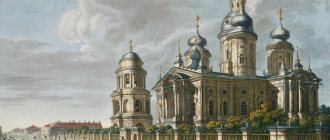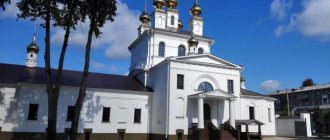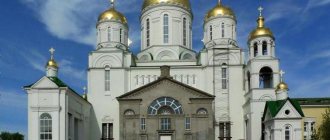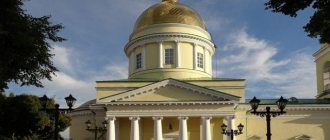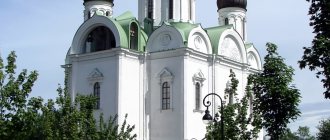The Cathedral of the Exaltation of the Cross immediately attracted my attention with its unusual appearance and majestic image of the crucifixion on the facade. Now it is an Orthodox church, but this, of course, was not always the case. This prominent building with a Christian cross on the façade once housed the Lutheran-Evangelical Church of the Kreuzkirch, the Church of the Cross.
The building itself also has the shape of a Greek (equal-pointed) cross when viewed from above. Today we will no longer see the clock that decorated the covered gallery located between the two towers above the image of the cross, as well as the sculpture of the pelican - a symbol of Christian sacrifice and faith, but this does not make the cathedral any less recognizable.
The architectural style of the building is late modern with elements of Gothic and neoclassicalism.
The Cathedral of the Exaltation of the Cross is an active temple. I recommend coming here to examine the building itself, as well as the unique amber iconostasis that appeared here after reconstruction. You may also be lucky enough to hear the local choir accompanying services on weekends and holidays. The choir participates in Orthodox festivals in Russia and abroad, and also records discs that can be a good souvenir in memory of a visit to the Cathedral of the Exaltation of the Cross.
Where is the cathedral
You can find the Holy Cross Cathedral at the address: Ligovsky Prospekt, 128.
Coordinates:
- 59°54'58" N
- 30°21'14"E
You can get to the temple by metro. You should get off at the Ligovsky Prospekt and Obvodny Kanal stations. From here the journey on foot will be short – 5-10 minutes. You can get to the cathedral by trams No. 44 and No. 25. There is also a bus stop near the temple. Public transport No. 74 and No. 3 stop here.
History of the cathedral
The Cathedral of the Exaltation of the Cross in St. Petersburg consists of a complex of several buildings. Next to it are the Tikhvin Church and the Church of St. Methodius and Cyril. Therefore, the history of the main building is closely connected with these 2 objects.
It all started in the very first time after the founding of St. Petersburg. Where modern Ligovsky Avenue passes, there was the Novgorod tract. It was the only artery connecting the city with the rest of the earth. The carriers and their families settled along the entire route.
Over time, the number of residents increased and the need for a church arose. In 1718, the archimandrite gave his blessing for the construction of the temple. The construction was carried out by Pyotr Kusov and Vasily Fedotov. They worked quickly and smoothly. This made it possible to erect a new building in a short time.
In 1719, the new temple underwent the consecration procedure. It was conducted by Hieromonk Varlaam, deputy of the Alexander Nevsky Monastery. The church was called John the Baptist. The first building was made in the style of Peter the Great's architecture. The characteristic features of this direction were the elongated facade of the building, a high roof decorated with a long spire.
There was no bell tower at that time. In 1723, a wooden 2-story belfry was built next to the temple. 4 bells were taken from the cannon yard. Each weighed 312 kg. An interesting fact is that these were products that Peter I took from monasteries with the aim of melting them down into weapons.
In 1730 there was a fire. He destroyed the wooden structure almost to the ground. In 1731, a chapel was purchased from the Okhta factory. It was brought and installed on the site of the burnt out temple. In the same year, on February 25, the clergyman Grigoriev consecrated the throne, and the chapel received the status of a church. Three years later, the Nikolsky chapel was built.
The materials from which the church was restored were of low quality. The walls were losing their stability and the roof was leaking. In 1740, parishioners submitted an appeal to the Holy Synod for a blessing for the construction of a new stone church.
They also proposed a new name for the building - the Church in honor of the Cross of the Lord. This was justified by the fact that there is no such name in all of St. Petersburg.
The Cathedral of the Exaltation of the Cross in St. Petersburg was built by the architect I. Schumacher. Information about the main architect remained in the records, but the information about the author of the project disappeared. The new stone temple was already made of stone, with 3 chapels. Each of them was personally illuminated by Archbishop Theodosius. The solemn event took place in 1748 on June 24.
Each chapel received its own name:
- Left from the north - named after. Saint Nicholas.
- The right one from the western part is named after. St. John the Baptist.
The temple was one level. It was not heated. Its shape is a Latin cross. The apse looked like a pentagonal protrusion on the eastern side. In the western part there was a vestibule. A bell tower was built over it.
The old church building was not used. It stood empty; parishioners did not go there. After public discussions, a petition was again sent to the Holy Synod. In it, people asked for the reconstruction of the old building. This was necessary in order to create a warm temple in which services could be safely held even in winter.
The townspeople's request was granted. The financial costs of construction were covered by the merchant Ilyin I. Thus, the Tikhvin Church was founded in 1764 on June 20. It was located just behind the altar of the Cathedral of the Exaltation of the Cross.
The plan of the building at the base had similar features to the structure of the church in 1748: the same elongated rectangle with a slight expansion on the eastern side. There were also 3 naves and 1 dome on an octagon. It, in turn, was decorated with pilasters. The naves were covered with vaults in the form of a cross.
In 1768, on December 14, the church already had a small dome. The building was ready to receive new parishioners. On this day the consecration ceremony was held. After this, Menshoi Ivan Ilyich sponsored the construction of the chapel. He was given the name of St. John Chrysostom. The extension was consecrated in 1800 on February 18. After 1 year, the annex of Nevsky A. was sprinkled with holy water.
The history of the construction of the bell tower began in 1804. It was in this year that the architect Postnikov made a design for the gate belfry. After approval by the Synod, they began to build the facility. It was put into operation in 1812. Thanks to this object, a harmonious and beautiful complex was created. The 2nd chapels were connected to the belfry by covered passages.
Statues of the Apostles Paul and Peter were placed in the recesses of the bell tower. The bell tower stretched 60 m in height. In its upper levels there were 8 plaster images personifying the appearance of saints. There were only 4 such decorations at the bottom.
Bell tower of the Cathedral of the Exaltation of the Cross in St. Petersburg, 1812.
In 1853, the blacksmith Fedor Martyanov made forged iron gratings. They were inserted into the spans. There were 12 bells on the 2nd level of the belfry. The merchant Ivan Shigalev (he had great influence on the temple) had his wife die in 1872. In memory of her, the man made a church of St. in the tower. Methodius and Cyril.
The project was developed by Buglieri. In 1872, on February 2, the temple was consecrated. The ceremony was performed by Metropolitan Isidore. You could enter the church via a stone staircase consisting of 40 steps.
The Holy Cross Cathedral with its bell tower in St. Petersburg in 2021 is considered one of the most beautiful places in the city. The complex dominates the architecture of the area. When the bell tower was built, a fence was installed around the perimeter. Its length was 0.6 km.
After the Tikhvin and Holy Cross churches were built, they fulfilled their mission - holding services for 100 years. Time did not spare the buildings, and they gradually collapsed.
Architect Morgan V. began the reconstruction project. He made a drawing that resembled the unfinished St. Isaac's Cathedral in its features. The new project had a direct reference to Greek culture. However, it combined well with the already built bell tower. The new church building was supposed to accommodate 2.5 thousand parishioners.
But it was impossible to deprive a populous area of an Orthodox church. To solve this problem, the Tikhvin Church was expanded. After this, they began to reconstruct the Cathedral of the Exaltation of the Cross.
In 1844, the Nikolsky and Predtechensky chapels were moved to the Tikhvin Church. On June 24, 1844 they were consecrated. The building of the Tikhvin Church was eventually surrounded by a rectangle. Thanks to this, it increased in width by 8.5 m. A guard room and a sacristy were added to the increased length. Due to such modifications in the longitudinal walls, spacious arches were obtained.
Cathedral of the Exaltation of the Cross in St. Petersburg, 1864
All these transformations took not only time, but also all the money allocated for the project. I had to come up with a way out of the situation. The new project was more modest. It was compiled by Stasov’s student – Egor Ivanovich Dimmert.
In April 1848, construction work began. Building 1848-1851 combined elements of the church of the 1740s. Thus, parts of the foundation and walls on the western side remained. Reconstruction proceeded at a rapid pace. But the architect was not able to see his project live. He died before construction was completed.
In 1851, work on the interior of the building was near completion. An inscription was placed on the middle pillar, immediately below the temple throne. It indicated the time of illumination of the church, and the names of the Orthodox figures who performed the ceremony. In 1852, on June 1, the chapel of St. John the Baptist, and 7 days later - the department of St. Nicholas the Wonderworker.
The Cathedral of the Exaltation of the Cross entered the 19th century renewed and elegant. The city was growing, and the outskirts had already become more densely populated. The number of parishioners increased. Residents from the Ligovaya Side, as well as Cossacks, came to the temple for services. At that time they did not have their own temple.
At that time, the cathedral owned several chapels:
- Near Rastannaya Street, on Ligovka. It was built from 1893 to 1894. The project was developed by Prussak V.F.
- Chapel near the Tsarskoye Selo railway. Every year a religious procession was sent to this place (June 25). The building was erected from 1895 to 1896. Funds for this were collected from all residents.
In 1875, within the walls of the Cathedral of the Exaltation of the Cross there was a Society for Relief of the Poor. There were 3 establishments under his patronage. 60 elderly women lived in the shelter. There were also dormitories for orphans. The children were taught in Sunday school.
In 1900, the temple opened a canteen for the poor. In 1913, temperance brethren operated within the walls of the church. At that time, the cathedral carried out extensive charitable activities. However, everything stopped in the 20th century. In 1932, in winter, the church was closed. Its building was converted into a school. Later, in the 1940s. workshops were made here.
Cathedral of the Exaltation of the Cross in St. Petersburg, 1900
Officially, from 1924 to 1938. the temple was under the protectorate of the Patriarchal Church. But ill-wishers pursued a terrifying policy, and a great threat loomed over the historical building. In 1938, a decree was written on the complete demolition of the temple. But he was still not accepted.
The Soyuzkinoprokat enterprise filed a petition to provide them with premises to house their office and storage facility. The request was granted by the Leningrad City Council. The new owners did not care about preserving the historical interiors.
At the same time, from 1937 to 1938. 8 clergy of the Cathedral of the Exaltation of the Cross were shot. At the same time, the Church of Methodius and Cyril was closed. With the advent of war in 1941, the temple became a morgue for Leningraders who died of starvation. Only in the spring they were buried in the Volkovsky churchyard.
The restoration of the temple began with the rehabilitation of the Russian Orthodox Church. In 1991, with the blessing of Metropolitan John, the transfer of the temple to the Cossack parish took place. Sergienko V. was appointed the first mentor. 3 weeks after this, a new titanium cross, 4 m high, was placed on the dome of the temple.
The first service within the walls of the temple was held in 1991 on May 24. Even photographs of this historical event have been preserved. But, if the Holy Cross Church still retained at least some greatness, the Tikhvin Church was in ruins.
Everything inside the building was mutilated. It had 2 floors, crosses and domes were eliminated. The premises were given over to workshops. The entire floor was covered with asphalt. The workers undressed in the altar and went to the vestibule to wash.
The building's appearance looked like a barracks, not a church. But the Cossacks decided to correct the actions of the Soviet government. They cleared the temple of debris and cleaned the machines. On Trinity Sunday, in 1993, the first prayer service was held within the walls of the church.
Yu.L. Petrov provided great financial assistance to the temple. Thanks to the efforts of the workers, a large-scale reconstruction was carried out. The dome was reinstalled and the ceilings of the 2nd floor were removed. In 2022, the Tikhvin Church is operational. All 3 thrones underwent a consecration ceremony.
In 2008, the city council allocated money to reconstruct the complex. The bell tower was renovated and the domes were covered with gold. The roof was repaired in 2014. The Cossacks worked the most at the temple. It was they who were able to give the church a majestic and ecclesiastical image. Through their efforts, more than 900 tons of construction waste were removed.
Thrones
In the Church of the Exaltation of the Holy Cross there are three altars: central, northern and southern.
- The central altar is consecrated in the same way as the temple itself: in honor of the Exaltation of the Holy Cross.
The name of the throne has a close connection with the history of Rus'. In the middle of the 17th century, a threat arose over the Orthodox faith. Troubled times have come for the Church. The cross, which came to us from Byzantium, became a symbol of Moscow Orthodoxy.
- The northern throne was consecrated in memory of the Mother of God.
The throne received its name in memory of the miraculous icon “Joy of All Who Sorrow,” located in the Transfiguration Church. There is a story about the miraculous power of the image that happened in 1688. The sister of Patriarch Joachim lived in Moscow, suffering from a terrible illness. During morning prayer, a voice from above advised her to go to the icon “Joy of All Who Sorrow.” She bowed before the miraculous image and was healed.
- The southern altar was consecrated in honor of the Council of the Archangel Gabriel. This saint was sent to the Virgin Mary to inform her and all Christians about the Immaculate Conception.
Architecture Features
The central place in the complex is occupied by the Holy Cross Cathedral. Architect Dimmert skillfully combined details of buildings that were built at different times. Thanks to the craftsmanship, the bell tower and the temple formed a single whole.
The church has a cruciform plan. It coincides well with Baroque and Russian-Byzantine styles. The walls are decorated with pilasters. The capitals are intricate and successfully emphasize the continuity of generations.
The expressive domes hint at the curved linearity of the domes. In fact, they are ordinary octahedrons, slightly elongated vertically. Their silhouette is complicated by figured lucarnes. At the side ones there are 8 of them for each side, and near the central head - 4, 1 for each of the cardinal directions.
All this goes well with the high bell tower. Its spire fits well into the overall urban planning picture. After all, similar details can be seen in the Peter and Paul Cathedral and the Admiralty. The Tikhvin Church, with its understated appearance, is not inferior to the Church of the Exaltation of the Cross due to its extended horizontal space.
After closing
The temple was closed in 1930. The drum and the head were broken, a superstructure was made over the quadrangle. The buildings located on the church grounds were demolished. Only the lower tier remains of the bell tower. A dormitory was set up in the temple premises.
They treated the wall paintings mercilessly: at first they began to paint them over, but after a while they began to show through the whitewash. And then the murals were simply knocked down. However, apparently there was not enough time for this, because most of the frescoes were still preserved. Then the hostel moved out, and the fittings workshop of the Moscow sewing association settled in the former church.
In total, the temple did not function for more than sixty years. Once someone even suggested demolishing it, but this project, fortunately, was abandoned. The building was even included in the list of objects proposed for state protection - they say, after all, it is a monument of the 17th century.
Interior decoration
XX century completely destroyed the original interior decoration of the temple. Only the majestic shell of the complex remains. Restorers tried to partially restore the finish. The support pillars were erected in their original places.
The internal space was expanded due to cross-shaped branches. In the side wings that appeared, the places of the demolished walls were marked with an arcade.
Schedule of services
The Cathedral of the Exaltation of the Cross in St. Petersburg holds Liturgies daily. It starts at 9:00. You can go to confession at 8:30. All-night services are held before Sunday and other religious holidays. During Lent, instead of an akathist, a prayer service is held.
Schedule of services (starts at 17:00):
- Wednesday – prayer service to all saints.
- Thursday – Akathist near the icon of Our Lady of Tikhvin.
- Friday is an akathist.
The schedule of services must be viewed on the official website of the temple. It shows changes over time. On Thursday, Friday and Wednesday a priest is on duty at the temple. He accepts confession, conducts services and answers questions.
Interiors and shrines
In former times, the temple contained a large number of icons that were lost during the revolution. However, in the 20th century. the cathedral has been transformed. Most of the shrines have references to Russian military glory. Here you can see images revered among the Cossacks.
One of them is the icon of St. George, the Great Martyr. She was rescued and then returned to the renovated temple. There is also an image of Fyodor Ushakov and Alexander Nevsky. There is also a piece of the relics of the noble prince.
Of particular pride is the icon of the Mother of God. It is located in the Tikhvin Church. It is easily distinguished by its ancient artistic technique. She was written off as a miraculous figure. Another icon is placed near the royal gate.
Also, in the Cathedral of the Exaltation of the Cross there is an icon of “Oranta”. The history of its origin is connected with military actions in 1941. Metropolitan Elijah received a sign, which he shared with the Orthodoxy of the Russian Church. Representatives of the clergy told Stalin about this. When Elijah visited the USSR, he left “Oranta” as a gift. Subsequently, the icon was given for storage to the Cathedral of the Exaltation of the Cross.
In 2022, the ceiling and walls of the temple will be decorated with paintings. In it you can see a description of the Holy Scriptures. Here and there you can see images of saints. The chapel of the church on the north side reflects the activities of Alexander Nevsky. The southern part is dedicated to the martyrs of the royal family.
TEMPLE OF THE CROSS TODAY
The Church of the Exaltation of the Cross received the status of a cathedral in 2000 and today has become a kind of “guild” temple, uniting people not just by a specific place of residence, but by their belonging to the glorious Cossacks. The Exaltation of the Cross Cossack Brotherhood and the Sisterhood in honor of the Tikhvin Icon of the Mother of God operate at the cathedral.
Living parish
The Cossack culture makes itself felt - the parish here is strong and truly alive: everyone has known each other for a long time, celebrate holidays together, go to services, help those in need, teach children, make pilgrimages...
In the church itself it is often said that the center of parish life is worship.
The whole world publishes the newspaper “Exaltation” here, dedicated to the history and traditions of the Cossacks and the Cathedral of the Exaltation of the Cross itself. Newspaper publications tell about the priests who served in the temple, about its parishioners - thereby, as it were, throwing a bridge from the past to the present.
One of the foundations of this bridge is the revived Cossack community. Its predecessor appeared in the city on the Neva in 1899: the “St. Petersburg Society for Mutual Aid of Don Cossacks,” which the Cossacks among themselves called the Nevskaya Stanitsa.
The activities of the village were not limited to providing exclusively material assistance to Don residents who came to study in the capital. The society sought to unite all Cossacks who found themselves far from their native land. Funds were collected at balls and banquets, which were extremely popular among the residents of St. Petersburg. Daring songs and dances were replaced by readings of works by Don writers and entertaining stories from old-timers about days gone by. A colorful description of one of these evenings was preserved in the newspaper “Russian Invalid” dated December 10, 1902: “Cossack hats on the stage, lances with flags of the designated enemy, behind the canvas ... the luminaries of our ballet, Mrs. Astafieva-Kshesinskaya and Karsavina, hid their pretty faces , who were briskly selling Tsimlyansky and champagne... All the Don “nobility” gathered to help their relatives make at least a small contribution to the holy cause - the enlightenment of the Don region... They danced until the morning... Suffice it to say that many trumpeters went straight from the ball to the morning cleaning of horses. This was very bad for the trumpet players. But good for a ball. One must assume that the ball was financially successful, and the Don people danced more than a penny, which will help the villager, lost in the capital’s Putin, get back on the beaten track and stock up on precious mental baggage.”
And now the villagers take care of each other and their temple. They serve as altar servers, readers, and sing in the choir. It was not without their assistance that busts of Emperor Nicholas II, Empress Alexandra Feodorovna and Tsarevich Alexei Nikolaevich appeared near the walls of the Exaltation of the Cross Cathedral - this is how the connection between times, interrupted in the 20th century, was restored.
Patronal holidays
The following patronal feasts are held in the cathedral:
| date | Holiday |
| 22nd of May | In them Saint Nicholas and Archbishop of Lycia the Wonderworker. |
| December 19th | |
| September 27 | In honor of the cross of the Lord. |
| October 8 | Holiday dates are dedicated to St. Sergius, Abbot of Radonezh. |
| July 18 | |
| July 19 | |
| July 6 | |
| October 6 | In honor of the prophet John, the baptizer of the Lord. |
| July 7 | |
| 11 September | |
| the 25th of October | |
| March 19 | In honor of Tsar Constantine and his wife Helen. |
| June 3 |
You can visit the Holy Cross Cathedral on Ligovsky Prospekt in St. Petersburg not only during the holidays. This Orthodox monastery is always open to guests. The only thing that visitors need is the requirement to respect traditions. There is no need to make noise or disturb the peace inside the building.
Abbots
- ? Filimon Yankovsky (mentioned early 1880s)
- Pyotr Afanasyev (October 24, 1889 - December 9, 1897)
- Peter Troitsky (April 16, 1900 - 1911?)
- Alexy Gusev (May 1911 - mentioned 1916)
- John Dombrowski (1932 - October 1932)
- Vasily Kaeshko (October 1932 - May 1933)
- Feofan Tokarev (mentioned 1936; September 26, 1943 -?)
- Venedikt (Plyaskin) (March 14, 1945 - January 1946)
- Polycarp Chernyavsky (? - January 11, 1950)
- John Melnik (1961 - 2007)
- Oleg Tsvetkov (since September 1, 2011)
